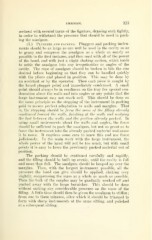Page 659 - My FlipBook
P. 659
AMAiGAM. 323
occlusal with several turns of the ligature, drawing each tightly,
in order to withstand the pressure that should be used in pack-
ing the amalgam.
(5.) Pluggers and packing. Pluggers and packing instru-
ments should be as large as can well be used in the cavity so as
to grasp and compress the amalgam as a whole as nearly as
possible in the first instance, and then used with all of the power
of the hand, and with just a slight shaking motion, which tends
to settle the amalgam into any irregularities or angles of the
cavity. The rope of amalgam should be broken in bits the size
desired before beginning so that they can be handled quickly
with the pliers and placed in position. This may be done by
an assistant or by the operator. Then each piece is caught by
the broad plugger i")oint and immediately condensed. A small
point should always be in readiness on the tray for special con-
densation about the walls and into angles or any points that the
large instrument may not reach well. This should be done on
the same principle as the stepping of the instrument in packing
gold to secure perfect adaptation to walls and margins. That
is, the stepping should l)e from the mass of the filling already
condensed toward the walls, finishing at the avails and wedging
the last hetween the ivalls and the portion already pacl'ed. In
using small instruments about the walls and angles, the force
should be sufficient to pack the amalgam, but not so great as to
force the instrument into the already packed material and cause
it to move. It requires some care to learn this and use force
judiciously. In the main work with the large instrument, the
whole power of the hand will not be too much, but with small
points it is easy to force the previously packed material out of
position.
The packing should be continued carefully and rapidly,
and the filling should be built up evenly, until the cavity is full
and more than full. The amalgam should be heaped up over the
margins. Then, with the largest instrument possible, all the
pressure the hand can give should be applied, shaking very
slightly, compressing the mass as a whole as much as possible.
Then the bulk of the surplus may be gradually worked off and
pushed away with the large burnisher. This should be done
without making any considerable pressure on the mass of the
filling. A little time should then be given the amalgam to stiffen;
from one to three minutes, after which it should be trimmed to
form with sharp instruments at the same sitting, and polished
at a subsequent sitting.


